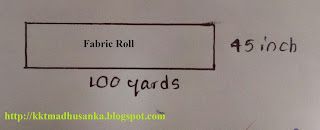4 Point System of Fabric Inspection
Fabric
Inspection Methods
Fabric
Inspection Procedure
4 Point System Solutions
4 Point System Calculations
4 Point System Solutions
4 Point System Calculations
Introduction
In
the textile and clothing industry the most of manufacturers purchase row
materials to produce garments. Fabric rolls are the best example to purchases.
But that purchased fabric rolls that cannot be used to directly cut and
spreading process. Because manufacturer doesn't know correctly how many damages
contains in that fabric roll. Therefore recheck process must be continued.
Hence, the higher damaged fabric roll cannot be used to produce garments. Because
of higher wastage and higher failure cost when launching operation process.
Therefore fabric inspection methods are very important to launch to eliminate
fabric faults. In the textile & clothing industry several fabric inspection
methods are employed.
1. 4
- Point System
2. 10
- Point System
3.
Mark and Spencer System
Today
I hope to give you an idea about produce and calculations of 4 - Point System.
Basic Principle
In
this method we check how many damages in the 100 yards2 .And here
maximum allocated points must be 4. If total points < 40 then roller can be
accepted. If total points > 40 then roller will be rejected. But today Sri
Lankan industry they are considering total points limitation as 28. So
according to that concept if total points < 28 then roller will be accepted.
However if total points > 28 then fabric roll will be rejected.
Damages and point allocated tables
Type of Defect
|
Point Value per Defect
|
3 inches or less
|
1
|
3 to 6 inches (3<x≤6)
|
2
|
6 to 9 inches(6<x≤9)
|
3
|
More than 9 inches
|
4
|
Hole: 1 inch or less than (Woven)
|
2
|
Hole of over 1 inch (woven)
|
4
|
Open tear (woven)
|
4
|
Calculations
In the fabric inspection
one fabric roll, fabric quality inspector found following observations.
Length of
the fabric roll = 100 yards and width of the fabric roll = 45 inches
Defects
of 3 inches long or lesser = 5
Defects
of over 3 inches but less than 6 inch = 4
Defects
of over 6 inches long but less than 9 inch = 2
Defects
of over 9 inches = 4
Holes
less than 1 inch = 1
Holes
over inch = 3
Aiding
basic principle of four point system calculate total points values and
distributing your data predicate whether this fabric roll accept or reject.
Answer
Above details can be distributed as below table.
Number of Defect
|
Point Value per Defect
|
Total Point Value
|
5
|
1
|
5 * 1 = 5
|
4
|
2
|
4 * 2 = 8
|
2
|
3
|
2 * 3 = 6
|
4
|
4
|
4 * 4 = 16
|
1
|
2
|
1 * 2 = 2
|
3
|
4
|
3 * 4 = 12
|
Total
|
49
|
Before analyze that total value, we must find area of fabric
roll.
Yards and inches are not same units hence, we have to
convert inch to yard.
1Yard = 36 Inch
Therefore,
Yard = 45/36
= 1.25 Yards
All area of fabric = 100 Yards * 1.25 Yards
= 125 Yard2
Now we can analyze how many points per 100 cm yard2
= (49/125) * 100
= 39.2
According to the 4 – point system, total points are less
than 40. Therefore 40 > 39.2
So, we can accept
this fabric roll
But according to the higher competition of each manufacturer
in the Sri Lankan industry, today they are considering total allocated points
as 28 maximum hence,
28 < 39.2
According to the above distribution we cannot accept to pass
this bundle to manufacturing process
Therefore finally we
will reject this bundle
Source : My answer of TTX4233 (Assignment - 02) at OUSL
in 2016
